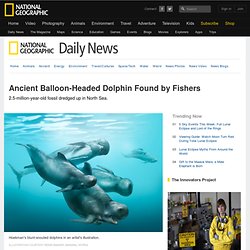

Hidden Fractals Suggest Answer to Ancient Math Problem. Researchers have found a fractal pattern underlying everyday math.

In the process, they’ve discovered a way to calculate partition numbers, a challenge that’s stymied mathematicians for centuries. Partition numbers track the different ways an integer can be divvied up. The number 3, for example, has three unique partitions: 3, 2 + 1, and 1 + 1 + 1. Partition numbers grow so fast that mathematicians have a hard time predicting them. “The number 10 has 42 partitions, but with 100 you have 190,569,292 partitions. Tech. Scientists Create Programmable Bacteria. Scientists Create Mice From 2 Fathers.
Canadian Microbes Give Clues for Life on Icy Moons. SAN FRANCISCO — A sulfur-loving microbe in the Canadian arctic could draw a blueprint for scientists searching for life on Jupiter’s icy moon Europa.

“Ultimately when we go to Europa, we’ll want to be able to tell if there’s any biological activity at all,” astrobiologist Damhnait Gleeson of NASA’s Jet Propulsion Laboratory told Wired.com here at the American Geophysical Union meeting Dec. 13. Europa’s thick ice crust may hide a dark liquid ocean, making the moon a favorite candidate for finding life beyond Earth in the solar system. Computer records animal vision in Laboratory - UC Berkeley. Wikileaked Cables from Beijing Reveal China's Pursuit of Fusion Power, Teleportation.
It's no secret that China is beating up on America and the West in everything from infrastructure to technology investment, but news of exactly what the People's Republic is up to is often scarce. So while the diplomatic establishment continues to reel from the stink of its own dirty laundry in last week's Wikileaks document dump, cables coming from the American Embassy in Beijing are also shedding light on the strides Chinese scientists are making in far-out fields like nuclear fission, biometrics, and even quantum teleportation. One confidential diplomatic cable sent from the Beijing Embassy to Washington in February suggests China is doing big things at the small scale. For one, China is aggressively expanding its nuclear energy resources, with plans to open at least 70 nuclear plants in the next decade.
More interestingly, the Chinese Academy of Sciences (CAS) is pouring research funding into its Institute of Plasma Physics (IPP) to conduct ongoing research into nuclear fusion. SOD_project by Guillaume Lehoux. Maniacal Webbed Metal.

Stone Agers Sharpened Skills 55,000 Years Earlier Than Thought. Stone toolmakers living in southern Africa 75,000 years ago pushed the cutting edge in more ways than one.

These intrepid folk sharpened the thin tips of heated stone spearheads using a forceful technique previously dated to no more than 20,000 years ago, a new study finds. This stone toolmaking method, called pressure flaking, was invented and used sporadically in Africa before spreading to other continents, according to a team led by archaeologist Vincent Mourre of the University of Toulouse-Le Mirail in France.
Having a flexible repertoire of toolmaking methods aided the survival of modern humans who left Africa beginning around 60,000 years ago, the scientists propose in the Oct. 29 Science. Video: 5-Foot Penguin Fossil Discovered. Scientists have unearthed fossilized remains of a five-foot-tall (150-centimeter-tall) penguin in present-day Peru. The 36-million-year-old fossil sheds light on bird evolution, according to National Geographic grantee Julia Clarke.
(The National Geographic Society owns National Geographic News.) Video produced by the University of Texas at Austin. Ancient Balloon-Headed Dolphin Found by Fishers. A new species of ancient balloon-headed dolphin has been identified from a fossil pulled up by fishers in the North Sea (map), a new study says.

The 2.5-million-year-old species was named Hoekman's blunt-snouted dolphin after Albert Hoekman, the Dutch fisher who trawled up a bone from the creature's snout in 2008. Measuring up to 20 feet (6 meters) long, the newfound dolphin had an extremely short and spoon-shaped snout that supported a large, high, and protruding forehead. (Related: "New, 'Chubbier' River Dolphin Species Found in Bolivia. ") Bulbous Head Helped Dolphin Navigate? In looks and size, the new species was similar to modern pilot whales—although its head was much more bulbous, said study author Klaas Post, an honorary curator at the Natural History Museum Rotterdam in the Netherlands.
(See "Pilot Whales Are 'Cheetahs of the Sea,' Study Finds. ")
Bubbly Ocean on Enceladus Explains Plume Mystery. New Cassini Findings Show Possible Signs of Methane-Based Life on Titan. Biggest sealife survey: Most ocean life is unknown. Ten-year census of marine life is the biggest ever survey ocean species Census: One million marine species exist but only approximately 250,000 have been formally describedDatabase includes 28 million observations of more than 120,000 speciesScientist: All surface life depends on life inside and beneath the oceans London, England (CNN) -- The planet's seas and oceans are richer and more diverse than scientists suspected, the biggest survey of marine life has revealed -- but many mysteries remain.
The Census of Marine Life, which announced its full findings Monday, has taken 10 years to complete, employing 2,700 scientists from 80 nations. First Four Exoplanet System Imaged. Want to stay on top of all the space news?

Follow @universetoday on Twitter Among one of the first exoplanet systems imaged was HR 8799. In 2008, a team led by Christian Marois at the Herzberg Institute of Astrophysics in Canada, took a picture of the system directly imaging three giant planets. The team revisited the system in 2009 – 2010 with the Keck II telescope and discovered a fourth planet in the system. The new planet, designated HR 8799e, orbits at a distance of 14.5 AU, making it the innermost planet in the system. The youth of these planets is part of what makes them an interesting target for astronomers. NASA to lead global asteroid response. What is going on in the brain when we experience déjà vu? Is altruism a genetic trait?

—Daniel Hall, Oceanside, Calif. Nicholas R. Eaton, a doctoral student in psychology at Washington University in St. Louis, responds, writing in collaboration with professor of clinical psychology Robert F. Beautiful Universe.